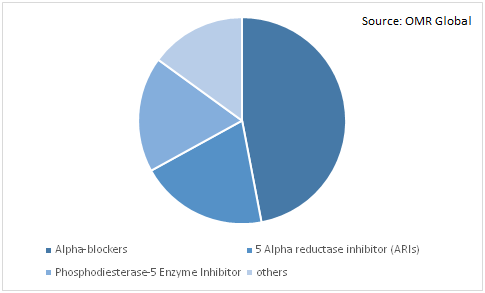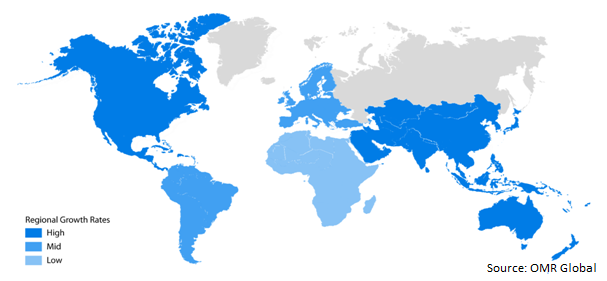Benign Prostatic Hyperplasia Treatment Market
Global Benign Prostatic Hyperplasia Treatment Market Size, Share & Trends Analysis Report, by Treatment (Medications {Alpha-blockers, 5 Alpha reductase inhibitor (ARIs), Phosphodiesterase-5 Enzyme Inhibitor, and Others}, Minimally Invasive Procedures {TURP, TUIP, TUMT, and TUNA}, Laser Therapy {Ablative procedures and Enucleation procedures}, and Others) and Forecast Period 2019-2025 Update Available - Forecast 2025-2035
The global benign prostatic hyperplasia market is estimated to grow at a CAGR of around 7% during the forecast period. Benign prostatic hyperplasia (BPH), is a condition in which men’s prostate gland gets enlarged, though not cancerous. Benign prostatic hyperplasia is also named as benign prostatic hypertrophy or benign prostatic obstruction. Men’s prostate gland gets enlarged mainly in two stages, first occurs during puberty, and second-growth occurs around age 25 and continues during most of a man’s life. This BPH mainly occurs during the second-growth phase. According to the National Institute of Diabetes and Digestive and Kidney Diseases (NIDDK), BPH is among the common prostate problem for men, who are older than age 50, and in 2010 in the US, nearly 14 million men had BHP symptoms. BPH affects nearly 50% of men between the ages of 51-60 and 90% of men age above 80.
The rising frequency of benign prostatic hyperplasia is the key factor, which is a major driver of this market growth. Besides, public awareness, the government initiatives, an increase in health budget are also driving the global benign prostatic hyperplasia market growth. Researchers found that there is an alarmingly increasing rate of benign prostatic hyperplasia among the middle-aged and old-aged men. Since people are less aware of the BHP, many country's governments are launching many awareness campaigns to spread awareness about BPH symptoms and treatment. For instance, the US health advocate and health authorities conduct prostate health awareness campaign the “National Prostate Health Month” every year in September, to educate the people about the risk and treatment, that are associates with benign prostatic hyperplasia.
Sometimes many patients suffered several types of side effects after benign prostatic hyperplasia treatment. After BPH surgery some patients suffer from urinary incontinence, discomfort during urination, and difficulty in completely emptying the bladder and others. For these side effects many patients who are suffering from BHP, don’t prefer BPH surgeries, resulting in decreasing demand for surgical devices. These side effects are the major restraints of this market growth. Technological innovation is a major opportunity of the global benign prostatic hyperplasia treatment market, such as innovation of laser therapy is among them.
Segmentation
The global benign prostatic hyperplasia treatment market is segmented based on treatment type. Based on the treatment type, the market is segmented into medications, minimally invasive procedures, laser therapy, and others. Based on medications,it is segmented into alpha-blockers, 5 alpha-reductase inhibitors (ARIs), a phosphodiesterase-5 enzyme inhibitor, and others. Based on minimally invasive procedures, it is segmented into transurethral resection of the prostate (TURP), transurethral incision of the prostate (TUIP), transurethral microwave thermotherapy (TUMT), and Transurethral Needle Ablation (TUNA). Based on laser therapy, it is segmented into ablative procedures and enucleation procedures.
The alpha-blockers segment held a significant share in the treatment segment
The alpha-blockers account for the largest market portion, owing to large numbers of drugs and high prefer ability across the globe. According to the US National Center for Biotechnology Information (NCBI), the US, alpha-blockers are the least costly and most effective drugs. Besides, alpha-blockers have very few side effects than other drugs. The US FDA approved four long-acting alpha 1 blockers for the treatment of BPH, that are terazosin, doxazosin, tamsulosin, and alfuzosin. All these drugs are well tolerated. Alfuzosin and tamsulosin don’t require titration. Independent of prostate size, terazosin, alfuzosin, and doxazosin are all effective in curing benign prostatic hyperplasia. Doxazosin (Cardura) Prazosin (Minipress) Silodosin (Rapaflo) Tamsulosin (Flomax) are some of the major FDA approved alpha-blockers.
Global Benign Prostatic Hyperplasia Treatment Market Share by Medication, 2018 (%)

Regional Outlook
North America is expected to have a significant market share in the global benign prostatic hyperplasia treatment market due to the high prevalence rate of benign prostatic hyperplasia. Key factors that are driving the North American market are the availability of proper healthcare infrastructures and the presence of the major players offering innovative benign prostatic hyperplasia treatment procedures in the market. Moreover, the Asia-Pacific region is the fastest-growing benign prostatic hyperplasia treatment market, owing to the rise in various urological disorders. For instance, according to NCBI report, in China, the occurrence rate of BHP in the age groups 40-49 years is 2.9%, in the age group, 50-59 years is 29%, in the age group 60-69 years is 44.7%, in the age group 70-79 years is 58.1%, and for age greater than 79 years this rate is 69.2%. Moreover, large numbers of the patient, growing economy and increasing health awareness in the Asia-Pacific region is driving the market.
Global Benign Prostatic Hyperplasia Treatment Market Growth, by Region 2019-2025

Competitive Landscape
The major players operating in the benign prostatic hyperplasia treatment market include Allergan PLC, Eli Lilly, and Co., Merck & Co., Inc., Abbott Laboratories, Allergan, Inc., Astellas Pharma, Inc., Pfizer, Inc., Sanofi S.A., Karl Storz GmbH & Co. Kg, Lumenis,Ltd., Olympus Corporation,Boston Scientific Corp., and others.Mergers and acquisitions and product launches are considered as crucial strategies adopted by the market players to expand market share and gain a competitive advantage.
Few Recent Activities-
- In November 2018, Olympus invested in Medi-Tate Ltd., anIsraeli-based manufacturer of minimally invasive benign prostatic hyperplasia (BHP) devices. This investment strengthens the urology sector of Olympus.
- In October 2018, Boston Scientific acquired Augmenix Inc. Augmenix developed medical devices in the urology sector. SpaceOAR Hydrogel System is Augmenix one of the major products that is used for prostatic hyperplasia therapies.
- In March 2018, Boston Scientific acquired NxThera worth $406 million. NxThera is a US-based, it manufactures Rezum a minimally invasive therapy.
The Report Covers
- Market value data analysis of 2018 and forecast to 2025.
- Annualized market revenues ($ million) for each market segment.
- Country-wise analysis of major geographical regions.
- Key companies operating in the global benign prostatic hyperplasia treatment market. Based on the availability of data, information related to pipeline products, and relevant news is also available in the report.
- Analysis of business strategies by identifying the key market segments positioned for strong growth in the future.
- Analysis of market-entry and market expansion strategies.
- Competitive strategies by identifying ‘who-stands-where’ in the market.
1. Report Summary
1.1. Research Methods and Tools
1.2. Market Breakdown
1.2.1. By Segments
1.2.2. By Geography
2. Market Overview and Insights
2.1. Scope of the Report
2.2. Analyst Insight & Current Market Trends
2.2.1. Key Findings
2.2.2. Recommendations
2.2.3. Conclusions
3. Competitive Landscape
3.1. Company Share Analysis
3.2. Key Strategy Analysis
3.3. Key Company Analysis
3.3.1. Allergan PLC
3.3.1.1. Overview
3.3.1.2. Financial Analysis
3.3.1.3. SWOT Analysis
3.3.1.4. Recent Developments
3.3.2. Eli Lilly and Company
3.3.2.1. Overview
3.3.2.2. Financial Analysis
3.3.2.3. SWOT Analysis
3.3.2.4. Recent Developments
3.3.3. Merck & Co., Inc.
3.3.3.1. Overview
3.3.3.2. Financial Analysis
3.3.3.3. SWOT Analysis
3.3.3.4. Recent Developments
3.3.4. Lumenis, Ltd.
3.3.4.1. Overview
3.3.4.2. Financial Analysis
3.3.4.3. SWOT Analysis
3.3.4.4. Recent Developments
3.3.5. Olympus Corp.
3.3.5.1. Overview
3.3.5.2. Financial Analysis
3.3.5.3. SWOT Analysis
3.3.5.4. Recent Developments
3.3.6. Karl Storz GmbH& Co.Kg
3.3.6.1. Overview
3.3.6.2. Financial Analysis
3.3.6.3. SWOT Analysis
3.3.6.4. Recent Developments
4. Market Determinants
4.1 Motivators
4.2 Restraints
4.3 Opportunities
5. Market Segmentation
5.1. Global Benign Prostatic Hyperplasia Treatment Market by Treatment
5.1.1. Medications
5.1.1.1. Alpha-blockers
5.1.1.2. 5 Alpha reductase inhibitor (ARIs)
5.1.1.3. Phosphodiesterase-5 Enzyme Inhibitor
5.1.1.4. Others
5.1.2. Minimally Invasive Procedures
5.1.2.1. Transurethral Resection of the Prostate (TURP)
5.1.2.2. Transurethral Incision of the Prostate (TUIP)
5.1.2.3. Transurethral Microwave Thermotherapy (TUMT)
5.1.2.4. Transurethral Needle Ablation (TUNA)
5.1.3. Laser Therapy
5.1.3.1. Ablative procedures
5.1.3.2. Enucleation procedures
5.1.4. Others (Surgery, Prothetic urethral lift, Embolization)
6. Regional Analysis
6.1. North America
6.1.1. United States
6.1.2. Canada
6.2. Europe
6.2.1. UK
6.2.2. Germany
6.2.3. Italy
6.2.4. Spain
6.2.5. France
6.2.6. Rest of Europe
6.3. Asia-Pacific
6.3.1. China
6.3.2. India
6.3.3. Japan
6.3.4. Rest of Asia-Pacific
6.4. Rest of the World
7. Company Profiles
7.1. Abbott Laboratories
7.2. Allergan, Inc.
7.3. Astellas Pharma, Inc.
7.4. Boehringer Ingelheim GmbH
7.5. Boston Scientific Corp.
7.6. Camber Pharmaceuticals, Inc.
7.7. Coloplast A/S
7.8. Daiichi Sankyo Co., Ltd.
7.9. Eli Lilly &Co.
7.10. Endo International PLC
7.11. GlaxoSmithKline PLC
7.12. Karl Storz GmbH& Co.Kg
7.13. Lumenis, Ltd.
7.14. Merck & Co., Inc.
7.15. Nymox Pharmaceutical Corp.
7.16. Olympus Corp.
7.17. Pfizer, Inc.
7.18. ProArc Medical, Ltd.
7.19. Sanofi S.A.
7.20. Sophiris Bio Corp.
7.21. Sun Pharmaceutical Industries, Ltd.
7.22. Synthon B.V.
7.23. Teva Pharmaceutical Industries, Ltd.
7.24. Urologix, Inc.
7.25. Veru, Inc.
1. GLOBAL BENIGN PROSTATIC HYPERPLASIA TREATMENT MARKET RESEARCH AND ANALYSIS BY TREATMENT, 2018-2025 ($ MILLION)
2. GLOBAL MEDICATIONS MARKET RESEARCH AND ANALYSIS BY REGION, 2018-2025 ($, MILLION)
3. GLOBAL MINIMALLY INVASIVE PROCEDURE MARKET RESEARCH AND ANALYSIS BY REGION, 2018-2025 ($ MILLION)
4. GLOBAL LASER THERAPY MARKET RESEARCH AND ANALYSIS BY REGION, 2018-2025 ($ MILLION)
5. GLOBAL OTHER TREATMENT MARKET RESEARCH AND ANALYSIS BY REGION, 2018-2025 ($ MILLION)
6. GLOBAL BENIGN PROSTATIC HYPERPLASIA TREATMENT MARKET RESEARCH AND ANALYSIS BY GEOGRAPHY, 2018-2025 ($ MILLION)
7. NORTH AMERICAN BENIGN PROSTATIC HYPERPLASIA TREATMENT MARKET RESEARCH AND ANALYSIS BY COUNTRY, 2018-2025 ($ MILLION)
8. NORTH AMERICAN BENIGN PROSTATIC HYPERPLASIA TREATMENT MARKET RESEARCH AND ANALYSIS BY TREATMENT, 2018-2025 ($ MILLION)
9. EUROPEAN BENIGN PROSTATIC HYPERPLASIA TREATMENT MARKET RESEARCH AND ANALYSIS BY COUNTRY, 2018-2025 ($ MILLION)
10. EUROPEAN BENIGN PROSTATIC HYPERPLASIA TREATMENT MARKET RESEARCH AND ANALYSIS BY TREATMENT, 2018-2025 ($ MILLION)
11. ASIA-PACIFIC BENIGN PROSTATIC HYPERPLASIA TREATMENT MARKET RESEARCH AND ANALYSIS BY COUNTRY, 2018-2025 ($ MILLION)
12. ASIA-PACIFIC BENIGN PROSTATIC HYPERPLASIA TREATMENT MARKET RESEARCH AND ANALYSIS BY TREATMENT, 2018-2025 ($ MILLION)
13. REST OF THE WORLD BENIGN PROSTATIC HYPERPLASIA TREATMENT MARKET RESEARCH AND ANALYSIS BY TREATMENT, 2018-2025 ($ MILLION)
1. GLOBAL BENIGN PROSTATIC HYPERPLASIA TREATMENT MARKET SHARE BY TREATMENT, 2018 VS 2025 (%)
2. GLOBAL BENIGN PROSTATIC HYPERPLASIA TREATMENT MARKET SHARE BY GEOGRAPHY, 2018 VS 2025 (%)
3. US BENIGN PROSTATIC HYPERPLASIA TREATMENT MARKET SIZE, 2018-2025 ($ MILLION)
4. CANADA BENIGN PROSTATIC HYPERPLASIA TREATMENT MARKET SIZE, 2018-2025 ($ MILLION)
5. UK GLOBAL BENIGN PROSTATIC HYPERPLASIA TREATMENT MARKET SIZE, 2018-2025 ($ MILLION)
6. FRANCE BENIGN PROSTATIC HYPERPLASIA TREATMENT MARKET SIZE, 2018-2025 ($ MILLION)
7. GERMANY BENIGN PROSTATIC HYPERPLASIA TREATMENT MARKET SIZE, 2018-2025 ($ MILLION)
8. ITALY BENIGN PROSTATIC HYPERPLASIA TREATMENT MARKET SIZE, 2018-2025 ($ MILLION)
9. SPAIN BENIGN PROSTATIC HYPERPLASIA TREATMENT MARKET SIZE, 2018-2025 ($ MILLION)
10. ROE BENIGN PROSTATIC HYPERPLASIA TREATMENT MARKET SIZE, 2018-2025 ($ MILLION)
11. INDIA BENIGN PROSTATIC HYPERPLASIA TREATMENT MARKET SIZE, 2018-2025 ($ MILLION)
12. CHINA BENIGN PROSTATIC HYPERPLASIA TREATMENT MARKET SIZE, 2018-2025 ($ MILLION)
13. JAPAN BENIGN PROSTATIC HYPERPLASIA TREATMENT MARKET SIZE, 2018-2025 ($ MILLION)
14. REST OF ASIA-PACIFIC BENIGN PROSTATIC HYPERPLASIA TREATMENT MARKET SIZE, 2018-2025 ($ MILLION)
15. REST OF THE WORLD BENIGN PROSTATIC HYPERPLASIA TREATMENT MARKET SIZE, 2018-2025 ($ MILLION)


